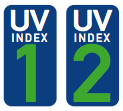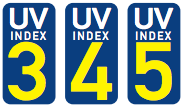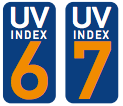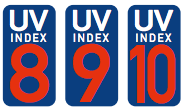The ultraviolet index (UV Index) is an international standard measurement of the strength of the ultraviolet (UV) radiation from the sun at a particular place on a
particular day. The purpose is to help people to effectively protect themselves from UV light, of which excessive
exposure causes sunburns, eye damage such as cataracts, skin aging and skin cancer.
Public-health organizations
recommend that people protect themselves (for example, by applying sunscreen to the skin and wearing a hat) when the
UV index is 3 or higher.
The UV-index is the daily maxima, which usually occurs during the noon-time hours. Similar UV intensities may occur for several hours on a sunny day, and the effect of a very high intensity over noon-time can be increased by lower intensities during the afternoon hours.
| UV Index | Description | Colour | Recommended personal protection |
|---|---|---|---|
 |
No danger to the average person | Green | Wear sunglasses on bright days; use sunscreen if there is snow on the ground, which reflects UV radiation, or if you have particularly fair skin. |
 |
Little risk of harm from unprotected sun exposure | Yellow | Wear sunglasses and use SPF 30+ sunscreen, cover the body with clothing and a hat, and seek shade around midday when the sun is most intense. |
 |
High risk of harm from unprotected sun exposure | Orange | Wear sunglasses and use SPF 30+ sunscreen, cover the body with sun protective clothing and a wide-brim hat, and reduce time in the sun from two hours before to three hours after solar noon (roughly 11:00 AM to 4:00 PM during summer in zones that observe daylight saving time). |
 |
Very high risk of harm from unprotected sun exposure | Red | Wear SPF 30+ sunscreen, a shirt, sunglasses, and a hat. Do not stay out in the sun for too long. |
 |
Extreme risk of harm from unprotected sun exposure | Violet | Take all precautions, including: wear sunglasses and use SPF 30+ sunscreen, cover the body with a long-sleeve shirt and trousers, wear a very broad hat, and avoid the sun from two hours before to three hours after solar noon (roughly 11:00 AM to 4:00 PM during summer in zones that observe daylight saving time). |



